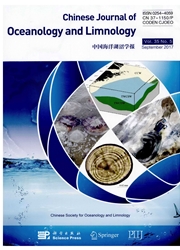

 中文摘要:
中文摘要:
Using shotgun sequencing data, the complete sequences of chloroplast 16S rRNA and tufA genes were acquired from native specimens of Bryopsis hypnoides (Qingdao, China). There are two group I introns in the 16S rRNA gene, which is structurally similar to that of Caulerpa sertularioides (Bryopsidales, Chlorophyta). The chloroplast-encoded tufA gene sequence is 1 230 bp long, very AT-rich (61.5%), and is similar to previously published 16S rRNA sequences of bryopsidinean algae. Phylogenetic analyses based on chloroplast 16S rRNA and tufA gene sequence data support previous hypotheses that the Bryopsidineae, Halimedineae, and Ostreobidineae are three distinct lineages. These results also confirmed the exclusion of Avrainvillea from the family Udoteaceae. Phylogenetic analyses inferred that the genus Bryopsis as sister to Derbesia; however, this clade lacked robust nodal support. Moreover, the phylogenetic tree inferred from rbcL GenBank sequences, combined with the geographical distributions of Bryopsis species, identified a strongly supportive clade for three differently distributed Asian Bryopsis species. The preliminary results suggesting that these organisms are of distinct regional endemism.
 英文摘要:
英文摘要:
Using shotgun sequencing data, the complete sequences of chloroplast 16S rRNA and tufA genes were acquired from native specimens ofBryopsis hypnoides (Qingdao, China). There are two group I introns in the 16S rRNA gene, which is structurally similar to that of Caulerpa sertularioides (Bryopsidales, Chlorophyta). The chloroplast-encoded tufA gene sequence is 1 230 bp long, very AT-rich (61.5%), and is similar to previously published 16S rRNA sequences of bryopsidinean algae. Phylogenetic analyses based on chloroplast 16S rRNA and tufa gene sequence data support previous hypotheses that the Bryopsidineae, Halimedineae, and Ostreobidineae are three distinct lineages. These results also confirmed the exclusion of Avrainvillea from the family Udoteaceae. Phylogenetic analyses inferred that the genus Bryopsis as sister to Derbesia; however, this clade lacked robust nodal support. Moreover, the phylogenetic tree inferred from rbcL GenBank sequences, combined with the geographical distributions of Bryopsis species, identified a strongly supportive clade for three differently distributed Asian Bryopsis species. The preliminary results suggesting that these organisms are of distinct regional endemism.
 同期刊论文项目
同期刊论文项目
 同项目期刊论文
同项目期刊论文
 The enhancement of cyclic electron flow around photosystem I improves the recovery of severely desic
The enhancement of cyclic electron flow around photosystem I improves the recovery of severely desic Optimization of conditions for tetraspore release and assessment of photosynthetic activities for di
Optimization of conditions for tetraspore release and assessment of photosynthetic activities for di Isolation and characterization of the oxygen-evolving photosystem II complex from the economical red
Isolation and characterization of the oxygen-evolving photosystem II complex from the economical red Variations in morphology and PSII photosynthetic capabilities during the early development of tetras
Variations in morphology and PSII photosynthetic capabilities during the early development of tetras PSI-Driven Cyclic Electron Flow Allows Intertidal Macro-Algae Ulva sp (Chlorophyta) to Survive in De
PSI-Driven Cyclic Electron Flow Allows Intertidal Macro-Algae Ulva sp (Chlorophyta) to Survive in De Sequence and phylogenetic analyses of the chloroplast 16S rRNA, tufA, and rbcL genes from Bryopsis h
Sequence and phylogenetic analyses of the chloroplast 16S rRNA, tufA, and rbcL genes from Bryopsis h Computational prediction of microRNAs and their targets from three unicellular algae species with co
Computational prediction of microRNAs and their targets from three unicellular algae species with co Purification of phycoerythrin from Porphyra yezoensis Ueda (Bangiales, Rhodophyta) using expanded be
Purification of phycoerythrin from Porphyra yezoensis Ueda (Bangiales, Rhodophyta) using expanded be TWO SPECIFIC CAUSES OF CELL MORTALITY IN FREEZE-THAW CYCLE OF YOUNG THALLI OF PORPHYRA YEZOENSIS (BA
TWO SPECIFIC CAUSES OF CELL MORTALITY IN FREEZE-THAW CYCLE OF YOUNG THALLI OF PORPHYRA YEZOENSIS (BA A Strategy for the Proliferation of Ulva prolifera, Main Causative Species of Green Tides, with Form
A Strategy for the Proliferation of Ulva prolifera, Main Causative Species of Green Tides, with Form Identification and characterization of microRNAs from Phaeodactylum tricornutum by high-throughput s
Identification and characterization of microRNAs from Phaeodactylum tricornutum by high-throughput s Study on the photosynthetic performances of Enteromorpha prolifera collected from the surface and bo
Study on the photosynthetic performances of Enteromorpha prolifera collected from the surface and bo Photosynthetic parameters of sexually different parts of Porphyra katadai var. hemiphylla (Bangiales
Photosynthetic parameters of sexually different parts of Porphyra katadai var. hemiphylla (Bangiales Production of polyhydroxybutyrate by the marine photosynthetic bacterium Rhodovulum sulfidophilum P5
Production of polyhydroxybutyrate by the marine photosynthetic bacterium Rhodovulum sulfidophilum P5 CHARACTERIZATION OF THE ALTERNATIVE OXIDASE GENE IN PORPHYRA YEZOENSIS (RHODOPHYTA) AND CYANIDE-RESI
CHARACTERIZATION OF THE ALTERNATIVE OXIDASE GENE IN PORPHYRA YEZOENSIS (RHODOPHYTA) AND CYANIDE-RESI Morphological and photosynthetic variations in the process of spermatia formation from vegetative ce
Morphological and photosynthetic variations in the process of spermatia formation from vegetative ce Subcellular localization of a lectin in Bryopsis hypnoides (Bryopsidales, Chlorophyceae) and its exp
Subcellular localization of a lectin in Bryopsis hypnoides (Bryopsidales, Chlorophyceae) and its exp Photosynthetic responses of thalli and isolated protoplasts of Bryopsis hypnoides (Bryopsidales, Chl
Photosynthetic responses of thalli and isolated protoplasts of Bryopsis hypnoides (Bryopsidales, Chl Immobilization of Chlorella sorokiniana GXNN 01 in alginate for removal of N and P from synthetic wa
Immobilization of Chlorella sorokiniana GXNN 01 in alginate for removal of N and P from synthetic wa 期刊信息
期刊信息
